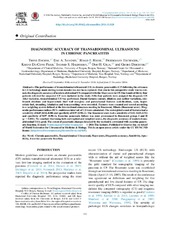| dc.contributor.author | Engjom, Trond | en_US |
| dc.contributor.author | Sangnes, Dag André | en_US |
| dc.contributor.author | Havre, Roald Flesland | en_US |
| dc.contributor.author | Erchinger, Friedemann Georg | en_US |
| dc.contributor.author | Pham, Khanh Do-Cong | en_US |
| dc.contributor.author | Haldorsen, Ingfrid S. | en_US |
| dc.contributor.author | Gilja, Odd Helge | en_US |
| dc.contributor.author | Dimcevski, Georg Gjorgji | en_US |
| dc.date.accessioned | 2017-08-04T12:37:30Z | |
| dc.date.available | 2017-08-04T12:37:30Z | |
| dc.date.issued | 2017-04 | |
| dc.Published | Engjom T, Sangnes DA, Havre R, Erchinger F, Pham KD, Haldorsen IS, Gilja OH, Dimcevski G. Diagnostic accuracy of transabdominal ultrasound in chronic pancreatitis. Ultrasound in Medicine and Biology. 2017;43(4):735-743 | eng |
| dc.identifier.issn | 0301-5629 | |
| dc.identifier.uri | https://hdl.handle.net/1956/16220 | |
| dc.description.abstract | The performance of transabdominal ultrasound (US) in chronic pancreatitis (CP) following the advances in US technology made during recent decades has not been explored. Our aim in this prospective study was to evaluate the diagnostic accuracy of modern abdominal US compared with the Mayo score in CP. One hundred thirty-four patients referred for suspected CP were included in the study. Fifty-four patients were assigned the diagnosis CP. After inclusion, transabdominal US was performed. Ductal features (calculi, dilations and caliber variations, side-branch dilations and hyper-echoic duct wall margins) and parenchymal features (calcifications, cysts, hyper-echoic foci, stranding, lobulation and honeycombing) were recorded. Features were counted and scored according to a weighting system defined at the international consensus meeting in Rosemont, Illinois (Rosemont score). Diagnostic performance indices (95% confidence interval) of US were calculated: The unweighted count of features had a sensitivity of 0.69 (0.54–0.80) and specificity of 0.97 (0.90–1). The Rosemont score had a sensitivity of 0.81 (0.69–0.91) and specificity of 0.97 (0.90–1). Exocrine pancreatic failure was most pronounced in Rosemont groups I and II (p < 0.001). We conclude that using both unweighted and weighted scores, the diagnostic accuracy of modern transabdominal US is good. The extent of pancreatic changes detected by the method is correlated with exocrine pancreatic function. | en_US |
| dc.language.iso | eng | eng |
| dc.publisher | Elsevier | eng |
| dc.rights | Attribution CC BY-NC-ND | eng |
| dc.rights.uri | http://creativecommons.org/licenses/by-nc-nd/4.0/ | eng |
| dc.subject | Chronic pancreatitis | eng |
| dc.subject | Transabdominal Ultrasound | eng |
| dc.subject | Mayo score | eng |
| dc.subject | Diagnostic accuracy | eng |
| dc.subject | Sensitivity | eng |
| dc.subject | Specificity | eng |
| dc.subject | Exocrine pancreatic function | eng |
| dc.title | Diagnostic accuracy of transabdominal ultrasound in chronic pancreatitis | en_US |
| dc.type | Peer reviewed | |
| dc.type | Journal article | |
| dc.date.updated | 2017-05-10T06:59:22Z | |
| dc.description.version | publishedVersion | en_US |
| dc.rights.holder | Copyright 2016 The Author(s) | |
| dc.identifier.doi | https://doi.org/10.1016/j.ultrasmedbio.2016.11.020 | |
| dc.identifier.cristin | 1467655 | |
| dc.source.journal | Ultrasound in Medicine and Biology | |

